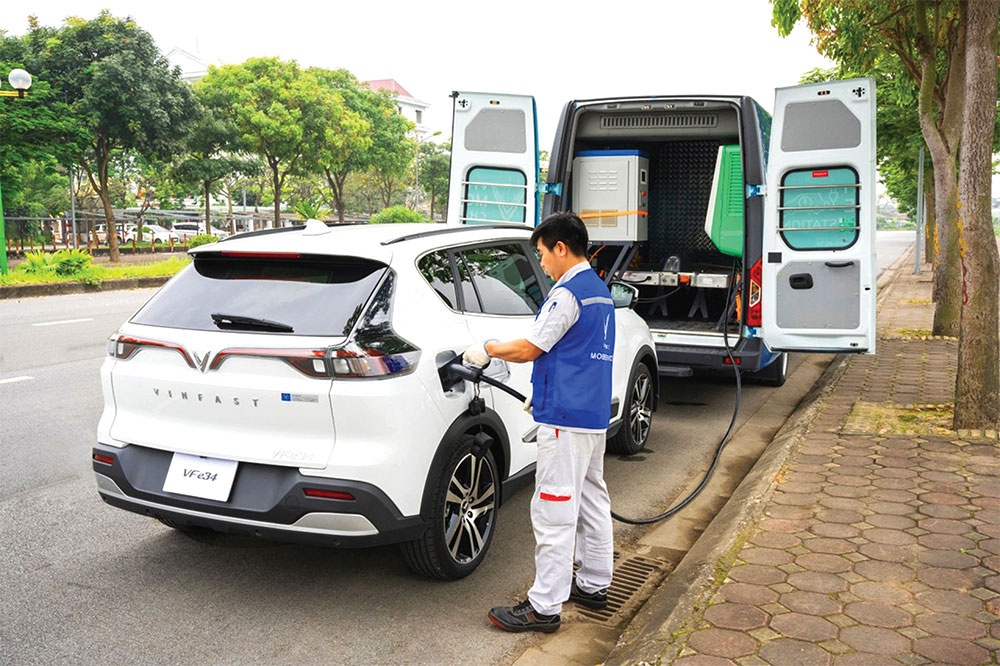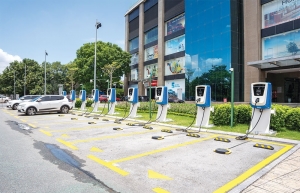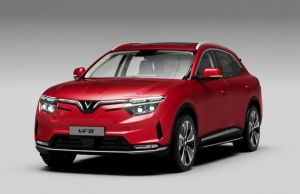Standardised charging a must for adoption of e-cars
Pham Tuan Anh, deputy director of the Department of Industry at the Ministry of Industry and Trade (MoIT), said the problem of planning charging stations for electric vehicles (EVs) involves many ministries, including the MoIT providing the source and the Ministry of Transport planning infrastructure locations.
 |
| Companies dabbling in electric vehicles are currently using their own technology, which could lead to new issues down the line, photo Le Toan |
Besides that, the standard of plugs for charging connection ports varies from region to region, and depends on the design of each vehicle model.
“The standard system of electric vehicles and charging systems in the world is diverse and continues to be developed. Each country, depending on its conditions, chooses and builds an appropriate system of standards,” he said.
Each EV manufacturer also uses different technology, so the charging standard differs. To develop a comprehensive system, it is necessary to have a multi-functional charging station system capable of supporting charging many different brands, according to Tuan Anh.
For instance, the US fast charging standard is CCS1/Tesla, the European charging standard is CCS2, Japan’s CHAdeMO, and China’s GB/T. However, developing a charging station system that can meet the needs of all EVs with different charging standards is a challenge.
Vietnamese automaker VinFast currently plans to install charging stations in all cities and provinces across the country. By the end of the year, the company plans to install 300 stations at PVOIL petroleum stations nationwide. VinFast has announced it will sell five models of EVs in the Vietnamese market, including VF5, VF6, VF7, VF8, and VF9 across the A, B, C, D, and E segments.
PVOIL chairman Cao Hoai Duong took part in a ceremony two months ago as VinFast installed its first electric car chargers at PVOIL stations. “EVs are a common trend developing strongly worldwide, leading to a wave of investment in charging station infrastructure. It is also taking place in Vietnam,” Duong said. “As one of the leading petroleum businesses in Vietnam, the cooperation with VinFast is the first step in a strategy for PVOIL to adapt to the inevitable trend of energy transition.”
Meanwhile, ABB has delivered a range of charging solutions for Audi Tan Binh, the largest Audi service centre in Vietnam. ABB chargers are compatible with electric vehicles of many different manufacturers. However, the number of ABB charging systems in the country remains limited.
ABB said while the Vietnamese government’s incentives for e-mobility are in the first phase, the progress in e-mobility driven by well-established vehicle manufacturers shows the important role electric cars will play in the future.
“Vietnam needs new solutions to help its cities develop sustainably. Clean mobility solutions will play an essential role in improving the urban environment,” said Noel Hupont, vice president of ABB Vietnam.
Moreover, the issue of power source and grid infrastructure is also important in developing EVs in Vietnam. Previously, the country only calculated electrical energy for daily life and production, but now the nation must consider electric energy to ensure smooth and uninterrupted traffic.
Vo Quang Lam, deputy general director of state-run Electricity of Vietnam, said that when EVs come into operation with a complete station infrastructure, it will influence the electricity system across the country.
He explained that this meant the load for EVs could be increased from a few hundred MW to several GW in the following years. That is equivalent to about two units of Hoa Binh Hydropower Plant (each unit has a capacity of 240MW) or to the capacity of Lai Chau Hydropower Plant (1,200MW). This could go even higher if the charging station infrastructure continues to develop quickly.
If in 2030, electric motorbikes account for 34 per cent of the market share and EVs account for 30 per cent, the electricity demand in the transport sector will be nearly four billion kWh, equivalent to half the capacity of Hoa Binh Hydropower Plant.
Lam said the impact of EVs and charging stations on the power grid in Europe, the United States, and China showed that if the control and coordination were not reasonable, the charging time with the auxiliary graph load would increase power loss, voltage bias, and power quality problems.
“To integrate the charging station and the operation of electric cars in the power system, it is necessary to implement solutions such as building a model accounting for EV load; studying charging station influence on the power system; and creating laws to integrate the operation of electric car charging stations,” Lam said.
Vu Tan Cong Deputy general director Vietnam Automobile Industry and Trade Consulting Two factors noticeably affect EV popularity around the world – the price and the charging station network. At present, the cost of EVs is too high in comparison with motor vehicles equipped with conventional internal combustion engines and can be 1.6-1.8 times higher in price. This is because of the high cost of lithium batteries that are popularly used in EVs. As EV battery prices drop, the global supply of EVs and demand for their batteries are ramping up. Since 2010, the average price of a lithium-Ion EV battery pack has fallen from $1,200/kWh to just $130/kWh in 2021. We are hoping that by 2025 or 2030, the figure will be $80-85/kWh. Unlike traditional automobiles, EVs need to recharge their batteries after a certain amount of miles. EV driving distances per charge are now about 200-500km. In some EVs with the latest technologies, these figures come to 800-1,000km per charge. It is obvious that EVs need a charging station network nationwide for their normal operations. Without the charging station network, it is difficult for EVs to become popular. It is advisable for the government to make national technical regulations on charging stations and work out a master plan for charging station network development. Investments in such development can be implemented either by EV manufacturers, independent investors, or both. Vietnam’s automobile market is still very small in comparison but has a very high potential to develop. It is forecasted that the domestic market will reach 500,000 units by the end of 2022. The number of EVs in Vietnam is the lowest in the Asian market, and so the charging station network for EVs is small in comparison too. At present, EVs sold in the Vietnam market are mainly imported from overseas and supplied locally by VinFast. But the charging station network is still undeveloped. However, in line with Vietnam’s eco-social development from now to 2045, there are solid bases to believe that EVs will eventually be popular in this market. That means Vietnam’s ambition to see a domination of electric vehicles in the automobile market by 2045 is achievable. |
 | Collaborations necessary for Vietnam to embrace EV boom Installing a network of extensive and easy-charging stations could ignite Vietnam’s plan for producing electric automobiles in a short amount of time, with both authorities and business collaboration required to fulfil the ambition. |
 | VinFast up ahead in infrastructure utilities for EVs With its widespread charging station system, VinFast is taking the lead in the electric vehicle sector, which is influencing the launch of electric cars by other manufacturers. |
What the stars mean:
★ Poor ★ ★ Promising ★★★ Good ★★★★ Very good ★★★★★ Exceptional
Related Contents
Latest News
More News
- KK Group opens global flagship store in Ho Chi Minh City (January 19, 2026 | 11:52)
- Gia Lai draws over $1bn in new investment so far this year (January 19, 2026 | 11:50)
- Unlocking capital flows for strategic and suitable projects (January 18, 2026 | 09:00)
- ACV begins cargo terminal construction at Danang Airport (January 17, 2026 | 15:57)
- Viettel starts construction of semiconductor chip production plant (January 16, 2026 | 21:30)
- Bel expands Vietnam production with $19.7 million investment (January 16, 2026 | 16:07)
- ASML signals long-term commitment to Vietnam (January 16, 2026 | 12:00)
- Ho Chi Minh City starts construction of four key infrastructure projects (January 15, 2026 | 17:22)
- PIDG invests with AquaOne to expand Xuan Mai’s treated water supply to Hanoi (January 15, 2026 | 11:16)
- Vietnam ranks 38th in global AI adoption (January 14, 2026 | 16:01)


 Tag:
Tag:





















 Mobile Version
Mobile Version